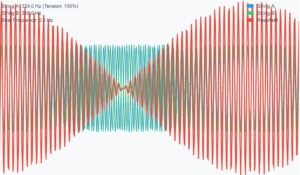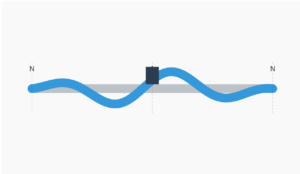Sitar Strings Beat Frequency Simulation
Example 14.6
Two sitar strings A and B playing the note 'Dha' are slightly out of tune and produce beats of frequency 5 Hz. The tension of the string B is slightly increased and the beat frequency is found to decrease to 3 Hz. What is the original frequency of B if the frequency of A is 427 Hz?
Answer: The original frequency of B is 422 Hz.
Example
Question:
Two sitar strings A and B playing the note Dha are slightly out of tune and produce beats of frequency 5 Hz. The tension of the string B is slightly increased and the beat frequency is found to decrease to 3 Hz. What is the original frequency of B if the frequency of A is 427 Hz?
Solution:
Increasing the tension of B increases its frequency. If B's original frequency (\(v_B\)) was greater than A's (\(v_A\)), increasing \(v_B\) would increase the beat frequency. But the beat frequency decreases, so \(v_B < v_A\).
Given: \(v_A - v_B = 5\,\mathrm{Hz}\), \(v_A = 427\,\mathrm{Hz}\).
\[
v_B = v_A - 5 = 427 - 5 = 422\,\mathrm{Hz}
\]
How It Works
This simulation demonstrates the beat frequency phenomenon that occurs when two sound waves of slightly different frequencies interfere with each other.
- String A is fixed at 427 Hz (as in the problem).
- String B starts at 422 Hz, creating a 5 Hz beat frequency (427 - 422 = 5).
- When you increase String B's tension, its frequency increases, reducing the beat frequency.
- The waves combine to create a pulsing "beat" effect shown in the visualization.
- Click "Play Sound" to hear the sitar strings and their beat pattern.



